Introduction
Just over a year ago, I acquired a bicycle – a Surly Karate Monkey (http://www.14degrees.org/en/?p=1547). Stock standard, the bike is a single-speed. In other words, it has only one gear. This is not conducive to the most efficient cycle touring in the world, so I splashed out and changed to a Shimano Alfine 8-speed internal gear hub (IGH).
As you can see, there one cog on the outside, and all the gears, in the form of, literally, gears, are on the inside of the hub shell. The beauty of this setup is that a bicycle with an IGH essentially becomes maintenance free (when one compares with a typical derailleur setup, where you have to clean multiple oily cogs quite often).
IGH’s do need maintenance every now and then, though. I’ve heard of some going for three years before being opened up, and the insides looking like new, but after one year, mine was starting to act up a little; a little more friction than usual, and it was sometimes taking a full half-rotation of the pedals in order for the drive to engage after free-wheeling. I live in Sapporo, Japan, and even though this is the land of Shimano, IGH-equipped bikes are extremely rare here, so there was little to no chance of having the hub serviced locally. Therefore, I decided it was time to pull the thing to bits and have a gander.
The most useful resource for learning about how to pull a Shimano Alfine 8-speed hub to bits was this video below.

Other resources included Nick Foster’s very recent post, of course Muddymole’s post, Ian’s page about the Nexus hub and adding an oil port (similar to the Alfine, but with less sealing), Lachlan Hurst’s post, wisdomfrom Ecovelo, bike mechanic Sam Larson, Thad at the Golden Wrench and his experiences, Aaron’s Bicycle Repair’s great resource, Sheldon Brown’s advice on lubrication for IGH’s, and last but not least, Hubstripping.com’s page on the Alfine 8-speed hub.
How to Do an Oil Bath on a Shimano Alfine 8-Speed Hub
Step 7
Some people have reported being able to screw open the dustcap by hand (it screws open clockwise, which is opposite to normal), but I had to take to it with a screwdriver to loosen it a little. Once the dustcap comes free, the whole hub shell will fall away from the insides.
On my hub, I noticed right away that water had entered the hub at some stage. I do vaguely remember the non-drive side cone being loose at one stage, and suspect that this was the culprit. If the cone is on properly, then the rubber seal should prevent any water from getting in. The rusty residue was not too bad though, and wiped off easily. After cleaning the hub shell, however, there were some visible blemishes on the bearing race, but no noticeable pitting.
To remove the drive-side bearing cage, the hub needs to be split into two pieces. This is achieved by removing the snap-ring at the non-drive side of the unit.
Step 8
The whole axle unit slides out of the main ring gear unit in two bits (explosion drawing here). There was no visible rust residue inside, so that was reassuring. I cleaned up the drive-side bearing cage, re-greased it, and put the two pieces back together. This is done by lining up the tab on the ring gear unit, and the groove in the axle unit. Even when the tab and groove are lined up, however, the gears need to be rotated around a little to get the ring gear unit to mate to the axle unit (this can take a while to get right).
Everything back together, with snap-ring re-installed, the whole lot gets dunked in auto transmission fluid. Mine was just normal, service station (gas station) ATF, using a 2 litre PET bottle as a dunking container.
Step 9
I left it in for about 5 minutes, and then let it drain for about 10 minutes while I was re-greasing the insides of the hub casing.
It is really important at this point to allow the hub to drain well. If too much ATF is left on the hub, it will leak out of the disk-brake (non-drive) side of the hub. If you have a disk brake installed, this will cause ATF to leak onto the disk, ruining your day.
Finishing Up
The innards then went back into the hub shell, the various dust covers put back on, the cog and snap-ring (which can be infuriating to get on) and the gear-shifting accessories. And then I took it all to bits again. No joke. I had put the drive-side bearing cage on the wrong way around. The picture above shows it in the correct orientation. That was not a happy moment when I had realised I had put it on wrong…
In all, it took me about 45 minutes plus another 20 minutes to rectify the bearing cage issue. Next time it will take around 30 minutes, I would say. That’ll probably be in another 12-18 months time.
Without the oil bath, the hub just has grease inside it. This means there is quite a lot of friction. For example, when back-pedaling the bike on a workstand, the back wheel will start to rotate backwards. With the oil bath, however, backpedaling does not affect the back wheel. I didn’t notice any difference in gear changing; that is as smooth as ever.


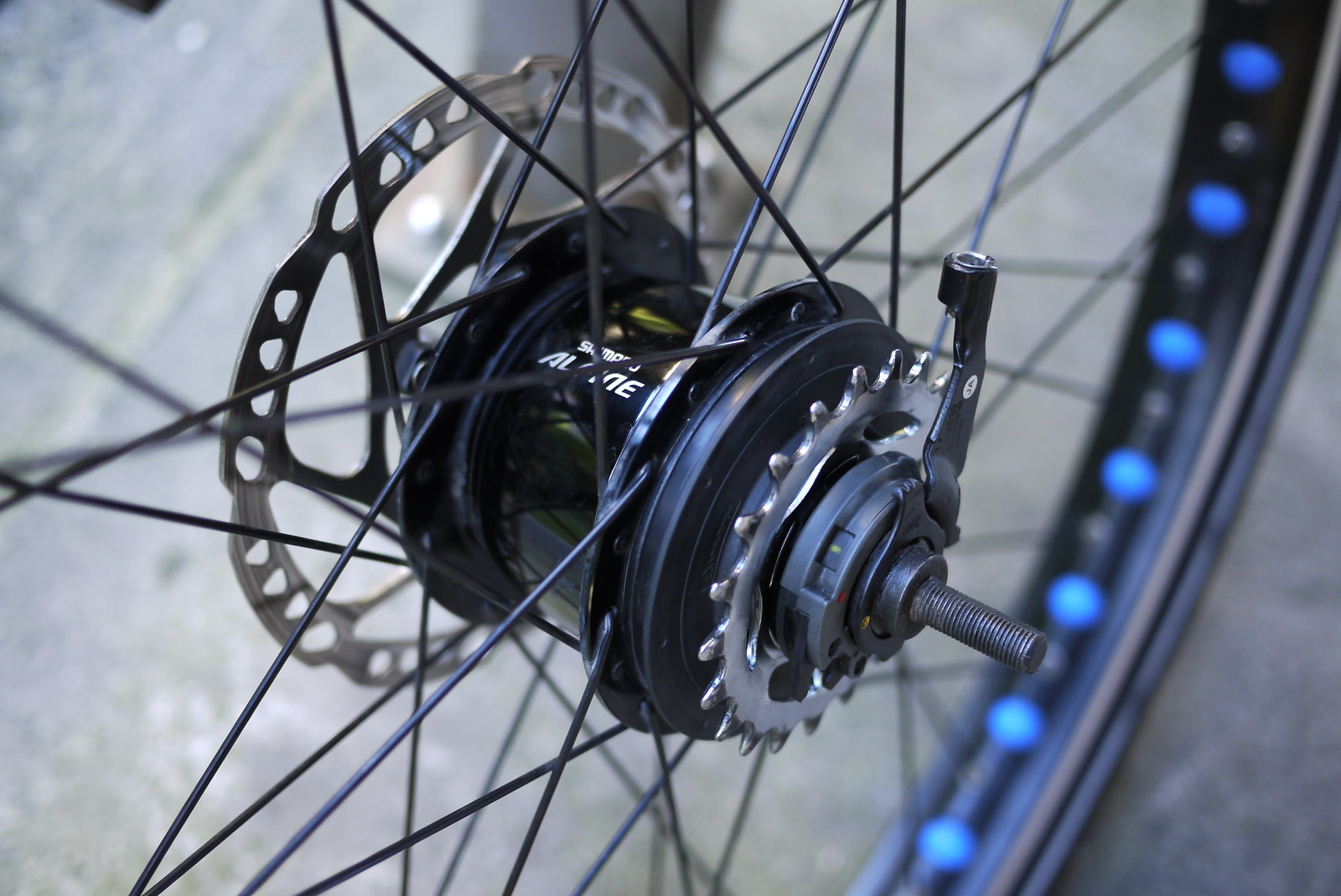
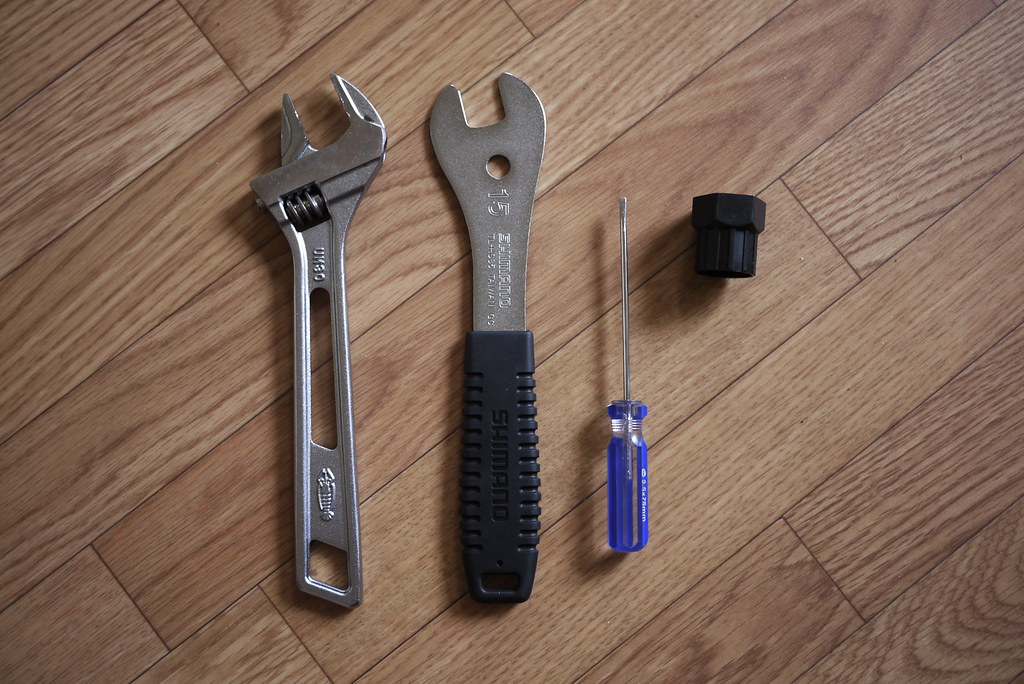
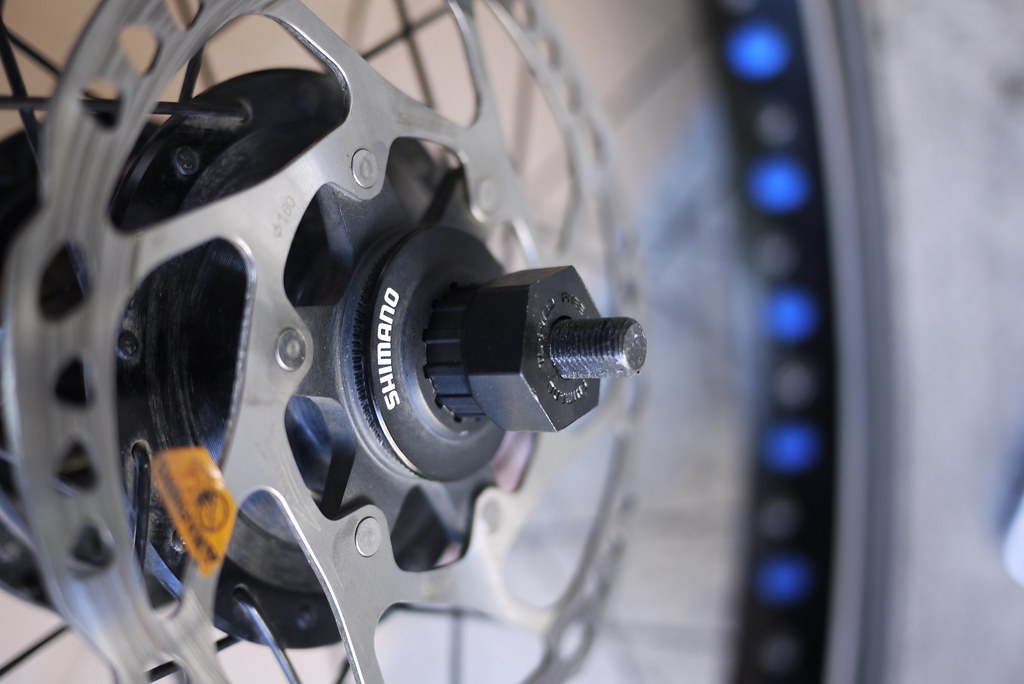

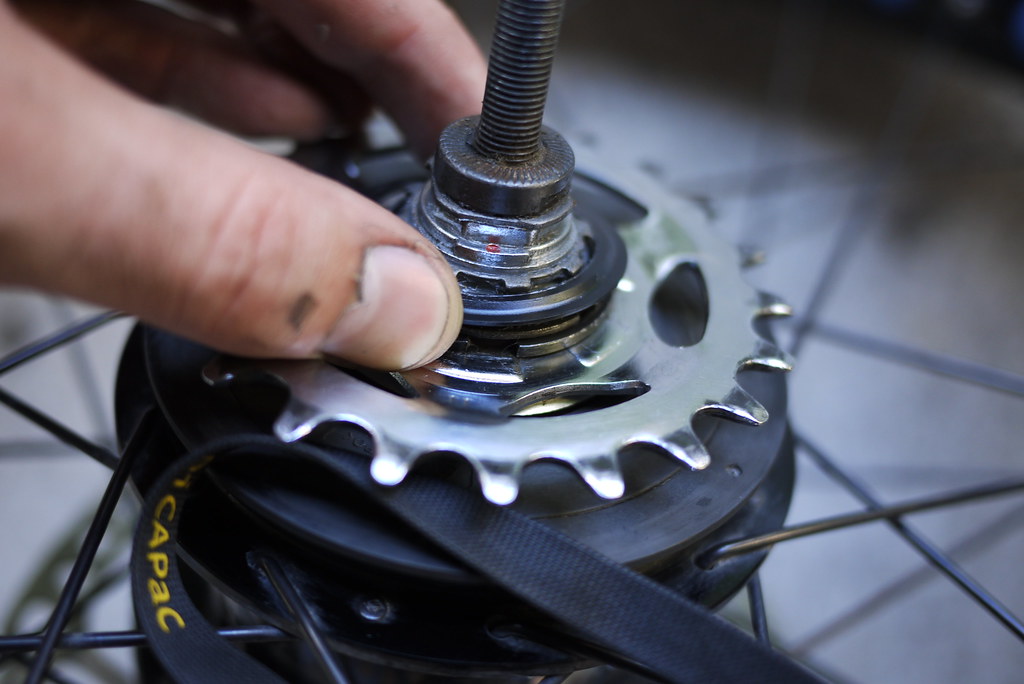
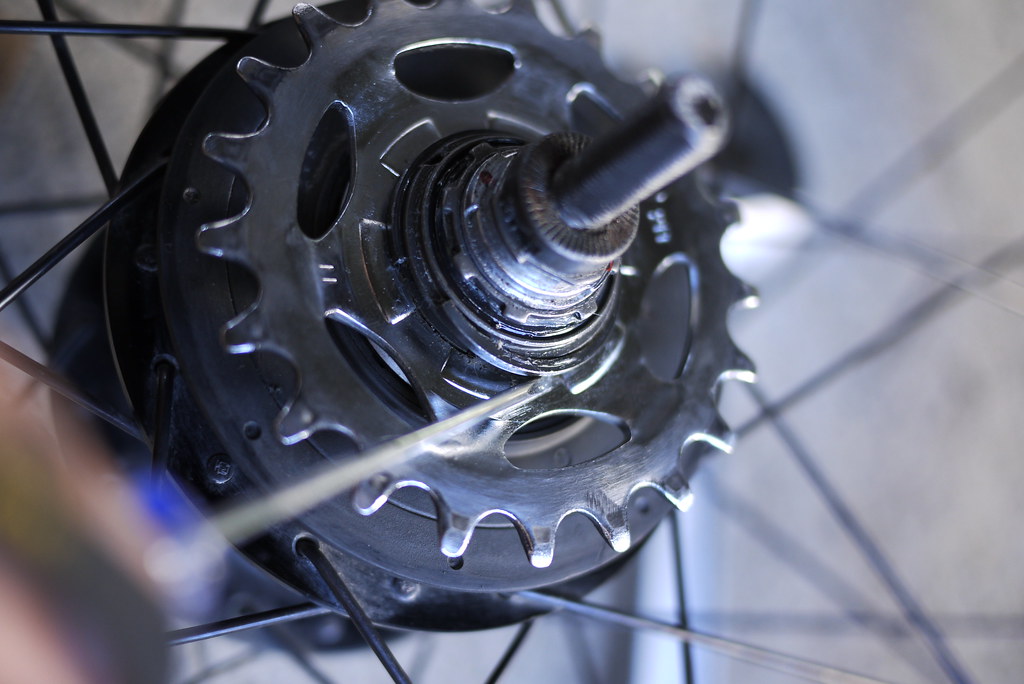

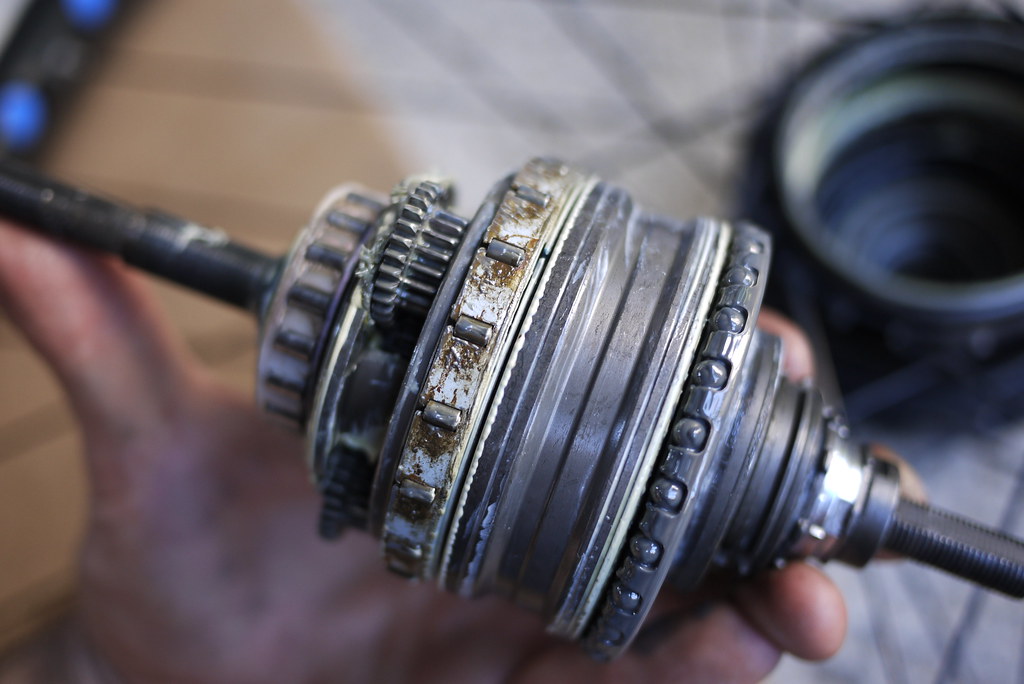
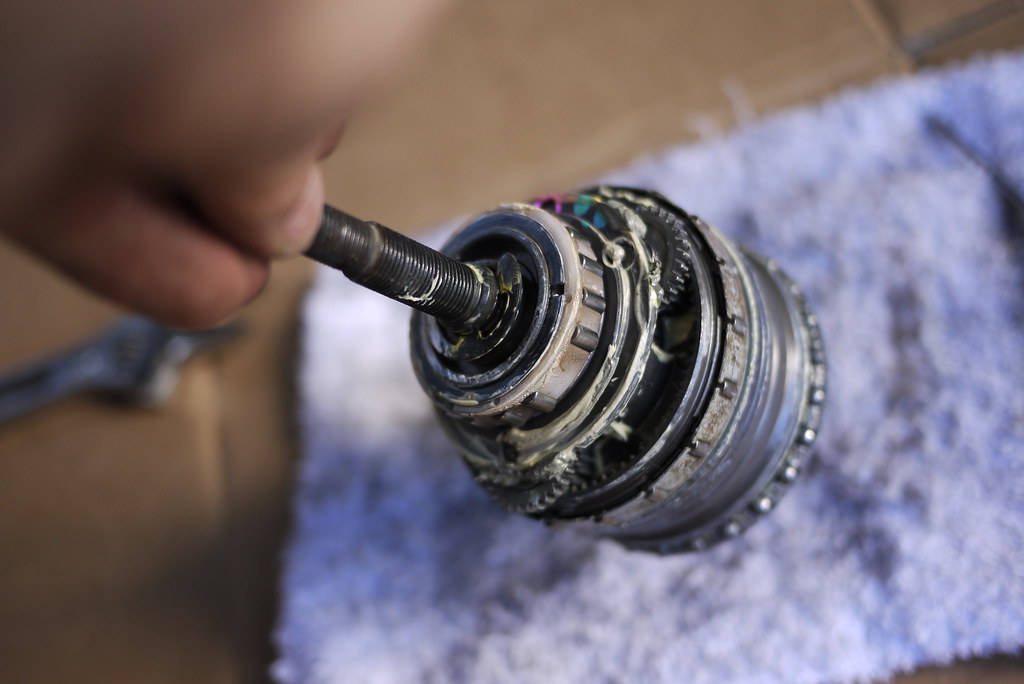







64 thoughts on “How to Convert a Shimano Alfine 8 Speed Internal Gear Hub to Oil Bath”
This is really helpful and makes the servicing possible without paying inflated prices for the
‘special’ transmission fluid. It is a clever gearbox and deserves being looked after.
youtube video says oil can past the seals and foul the brake rotor. Did this happen to you?
Yes. More than twice. Only on the left-hand side (the disk-brake side). Although, the official Shimano oil (https://amzn.to/2iwpzY2) is much better – it is more viscous than automatic transmissions fluid, and tends to leak less. It also may be a good idea to replace the left-hand cone (Part No. Y-35Z 98060) or just the seal ring (Part No. Y-377 10000) while you are doing the conversion (see this PDF document from Shimano for the parts reference: https://bit.ly/2hBcrnL (Shimano) or https://bit.ly/2iLE0dU (same PDF uploaded to my server)).
What are the odds of 2 dud hubs?
In Jan 2016 (Melbourne summer), I bought a BadBoy1 with an Alfine 8 hub. It ran like a dream for almost 6mths (daily commute – 2,500kms) until the chain started to slip. A new chain fixed that and I was back to nirvana. In Jan 2017, it started grinding when coasting so I visited my LBS. Water had gotten in and I got a new hub under warranty. Since Feb, I’ve had the new hub for 5 weeks (550kms) again with lots of rain and grit, and it has started grinding (just). My LBS took a look and accused me of using a high powered hose to clean the bike, because they found a little bit of water but told me the seals were “perfect”.
I’ve never cleaned the bike (!!!) so it is just poor lubrication at the factory (per Sheldon B)? Or that alarming theory about changing air temperature sucking water past the seals (internal temp vs external temp). I want at least another year hassle free thru rain and puddles ….. (if relevant the bike is usually stored hanging by the front wheel)
Hi, I’ve got a question… on the non-drive side there is a wheel bearing that rides in the hub body. My hub is like yours, it has a disk rotor, so this bearing is right inside the splined part of the hub where the rotor attaches. The odd thing I’ve run into is that there’s a piece in there, on top of the bearings, that is trapping the bearings. It appears to be part of the labyrinth seal that is provided by the cone. The cone has one part of the labyrinth, and in the hub, atop the bearings, is this other part, press-fit into the hub, as I said atop the bearings. I cannot get this piece out, and thus cannot get the bearings out to inspect them or inspect the bearing race.
Is your hub the same? Can you give any insight?
Update, I decided that this little ring must be just press-fit into the hub, like a dust cap, so I applied a little pressure with a screw driver and thus easily levered it out.
Hey Boris, you beat me to it. Yes, that little dust cap also fooled me for a while, until I discovered it was press fit and relatively easy to lever off. Using a puller of some sort would reduce the chance of deforming it though of course.
do you know the torque to tighten the lock and cone nuts?
Sorry, I have no idea!
Do you know if the oil-bath lubrication trick works on the Nexus 8 hub as well as the Alfine 8 hub? As I understand it, the internals are functionally identical, but maybe the Alfine has better seals to retain liquid oil?
As far as I know they both work fine. Better to use the official Shimano oil though. It seems to be thicker than standard auto transmission fluid, so doesn’t tend to leak as easily, at least from my experience.
Hi,
Great walk through for overhaul Alfine 8.
After my first year ride with Alfine 8, I have tried to service it for the first time.
Everything looks good and smooth until I remove the snap ring and try to split the main gear unit into 2 halves.
The 2 halves cannot separate completely and stuck. I tried to turn the ring gears to free the 2 halves. But there is no luck, I then reassemble the 2 halves together.
After that there are some click sounds in gear 4-8 during coasting.
Is it that I turn the ring gears so the line up is wrong and is causing these sound.
And if I disassemble it again, how do I know the ring gear is lined up?
Best regards,
Wah
Hey Wah,
When I took apart the main gear unit into two pieces, I had no problem to get them apart…just carefully wiggle them apart. For ring gear alignment, I remember that it cannot come back together unless it is aligned. Maybe check out this page for more resources: https://hubstripping.wordpress.com/alfine-shimano/
Thanks Rob.
Will look into it this weekend.
Cheers,
Wah
Hi Wah,
Any luck with your hub?
I have just serviced my Alfine 8 and also got these clicks during coasting on gears 5-8. 1-4 are perfectly silent. Dunno if it matters, but just like you, I was unable to completely detach the 2 parts.
What could potentially matter in my case is that first I dunk the hub in petrol to properly wash all its insides. Perhaps it washed some grease that was keeping a pawl in place while coasting and now the ATF does not.
Or maybe I was too generous with greasing the bearings / hub case. I have a feeling that there is more friction now when coasting, even when the axle bearing nut is loose, than it was before I serviced the hub.
Any thoughs? Anyone?
Cheers,
Seb
Hey Seb, did you spray the hub with parts cleaner after cleaning it with petrol? Any residue left from the petrol will not be good for the hub when it is re-greased and lubed.
Pingback: Mid Drive Kits, Dump the Derailleur and get an IGH? | ELECTRICBIKE.COM
I remove the internals. Soak in petrol, twisting the axle. Do this twice. Let it dry.
Then, i fill a tomato sauce squeeze bottle (one with a pointy nozzle) with a very high viscosity tractor gearbox oil. This is for bearings and clutch. I squirt a bit inside before joining the two halves. This is designed for manual gearbox’s that leak. So you get a light oil effect that won’t leak from the seals.
I then soak it in a normal gearbox box oil – usually valvoline.
I have a Nexus 8 on my commuting bike and do about 5K Km a year. I bought the hub in Germany in 2003 so it might be the oldest one in Australia. I dismantle it for an oil bath each Anzac day, but have a slightly different routine to what people describe above. Once I have the mechanics out of the shell I soak it in mineral turps to get all the black worn metal crud out, twisting the shaft to help flush it. I then blow it out with compressed air, at which stage even more crud comes out. I then dunk it in auto transmission fluid, let it drain then apply the special white Shimano internal hub grease to the gears and clutch, then reassemble using waterproof grease on the seals. The hub is getting noisy and a bit slow to change now, and its hard to keep the cones correctly adjusted so I think it might be nearing the end of its life.
I wonder if the auto transmission fluid is as good as the special Shimano oil bath. Does anyone have an opinion on that?
Hey Ben, thanks for the tips! As for the Shimano oil vs the auto transmission fluid, I think the biggest difference is the viscosity: the Shimano oil is less viscous, so it will leak less out of the seals. I’ve found that using the auto transmission fluid is OK, but it does seep a little out of my Alfine 8-speed hub.
Just to update that previous post, the hub started making weird freewheel noises it had never made before, and developed some internal resistance, so when rolling, the hub wanted to push the pedals around. At about that time the rim it was in developed a split, so i retired the whole unit even though the gears did work. Readers might like to know that the working life of a Nexus 8 hub seems to be about 10 years and 40k Km, Is a thousand km a megaM?
So I dropped in a new hub and rim, another Nexus 8, i love em.
Ben
Thanks for the update Ben!
Rob,
I’m very appreciative for the information you provided here…it was very helpful. My hub has about 6 years and many, many miles. I was surprised how good it looked inside, and how little grease Shimano had applied. I also followed some of the advice provided by the late Sheldon Brown – I included some oil (actually used a little synthetic Mobil1 ATF blended with Mobil1 5w20)….greased the bearings and races with lithium grease, and sealed everything up with some high quality waterproof grease.
The hub now seems very different – smoother and with less resistance. Also, the shifting is greatly improved.
I had communicated with Sheldon some many years ago, and he was the main reason I started riding internal hub bikes. He did mention in one of his articles that some of these hubs did not have adequate lubrication from the factory.
I have two more bikes with these hubs that I should service. Looking forward to it!
Thanks again!
Hi,
great instructions. My old alfine 8 broke (somehow water must have gotten inside and there was a lot of corrosion) and I am now preparing to install a new one. My question is just whether I should subject the new hub to an oil bath prior to installation, or whether I should just grease it? Any recommendations? And thanks in advance.
Thanks for the comment 🙂
My opinion is that an oil bath should only be done if there is an increase in resistance or other feeling of “something is wrong” in the hub. The vast majority of Alfine 8 speed hubs, and indeed the lower quality hubs go for years with no problems. Better to leave it greased, I think. The reason is that the Alfine 8 speed seals are not made to keep oil in…they do tend to seep a very small amount of oil after a conversion.
Alright, I will just grease it then. Thanks!
Thanks for the guide, I gave my hub a bath and some greese today. It made difference to the gear change and now everything feels smooth. Thanks.
Thanks for the post. The hub was surprisingly easy to get into. Even the snap ring behaved and was a lot easier to fit than the first time I installed it.
I’ve only had the hub for a couple of months but I decided to do an oil bath as it felt and sounded really rough. 5th gear especially. I’ve not put it back on my bike yet but I’m hoping this solves some of these issues
Just bought a ridgeback flight 04 hybrid with alpine 8speed of eBay ,previous owner said he had done about 500 miles .the gears seem like they are fought, so I think its time to open up and take a look ,will let you know how I got on ,iI wouldn’t attempted this job without your step by step instructions wish me luck!
I hope the service gives it a new lease on life!
Superb and concise illustration on doing this service. Hub working enormously better after 6K miles and wet climate. These pictures were perfect guidance.
So glad to hear that the service went well! Here’s to another 6k miles 😉
Thanks, I opened mine up today for the first time, oiled it up and it’s running beautifully smoothly again.
Great instructions, thanks for your help.
Great to hear Dean! How long were you running it before opening it up for the first time? And was there any particular reason you opened it up for an oil bath?
I have an Alfine 8, on my belt drive, Scott Sub 10. I love everything about it. It is working perfectly but I figure I had better bite the bullet and open it up soon, as I just ticked over 5,000km, after owning it for 16 months.
I live on the Sunshine Coast in Qld Australia, and although there are many bike shops, none of them want to touch it.
I have cleaned an old tin and I have some ATF, left over from a car service. I will be going for it soon. Thanks for all your advice fellas.
Glad to hear this post has helped (and sorry for the late reply). Did you end up having a look inside the hub?
Hi,
I’ve a Shimano Nexus 8 hub. I had previously taken it to LBS. I think the mechanic was not interested in taking hub apart. When I striped the hub today I was shocked at the amount of crud everywhere. The cage bearing was very loose, the ball bearings just fell out of it. I’ve ordered a new one £2.50. What’s the best method to clean all the crud off? Excellent article thank you.
@Kenny – I have seen somewhere someone using a hot oil bath, and I would say that that would be the ‘best’ way to get the internals completely clean and stripped of grease and crud. I guess it depends how deep into the internals the dirty grease has gone. If you can see crud all the way into the inside of the internals, you might need to really get drastic. Like hot oil bath drastic. I don’t have a hot oil bath, so I would possibly try soaking the internals in a bucket of petrol and rotate the hub/axle to work the crud out. Then spray the whole thing with parts cleaner to get rid of the petrol residue, and then do the transmission oil dunk. It would be a fairly big job with lots of mess, but possibly better than getting a new hub!
Thanks if your work above, I am going to service my Alfine 8 speed hub tomorrow. Your instructions have given me the confidence to take my hub to bits.
Nice one.
@Vic – Did the service go well?
Pingback: Inspecting my Shimano Alfine 8 IGH… « The Lazy Rando Blog…
Hi,
I just serviced my Alfine 8 this weekend using the oil bath.
Compared to the grease lubrication pedalling seems to be a bit smoother but now I can ‘feel’ the gears when applying power. Do you also notice this?
Regards,
Sjors
Hi Sjors, I had heard that switching to an oil bath does, naturally, reduce the “vibration dampening” that the grease provides. And yes, I can now “feel” the gears more. Have you ever ridden a Rolhoff hub? That’s one example of a hub where you can really feel the internal gears!